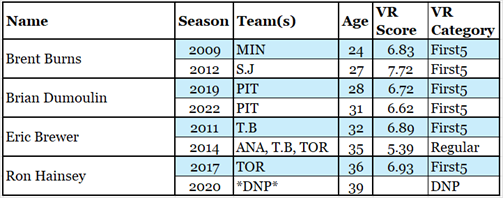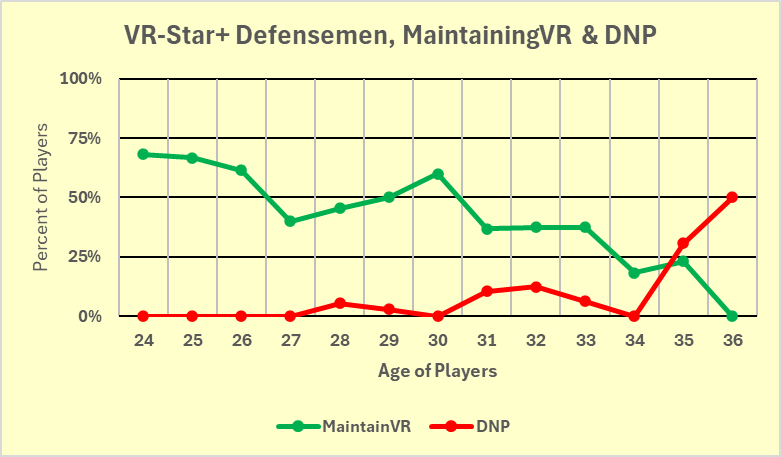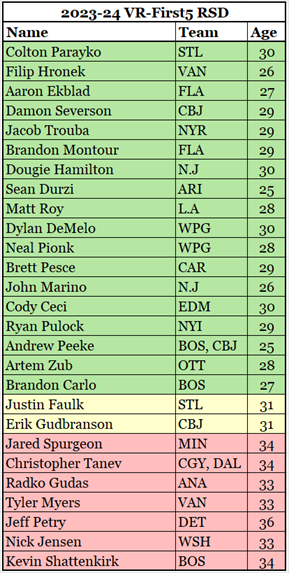The fans of the Ottawa Senators would love the team to acquire two right-shot defensemen. For several seasons now, Ottawa has tried to address their lack of talented RSDs by using LSDs (left-shot defensemen) out of their natural position, and those experiments have failed.
I thought I’d look at (almost) all of the RSDs in the league and evaluate how risky it would be to acquire them, defining risk as “the chances the player will be playing at his current level three seasons from now.” While the highest-level RSDs are either not available or not affordable, they will be included. Only low-skill RSDs will be excluded, as Ottawa must know by now that a fringe-level defenseman is not the answer to their problems .
Past, Present and Future
Past, present and future all have a part to play when one considers the acquisition of a player. NHL executives will consider those periods differently than I do and may not think of their considerations in the context of past/present/future.
A player’s past is defined by his statistics since he entered the league: the goals he scored in 2021-22, the hits he delivered in 2019-20, his poor season in 2022-23 and his great season in 2023-24. NHL executives may also consider a player’s junior statistics.
A player’s present is his current value, which for me is based on his statistics from 2023-24.
A player’s future is his probable value three seasons from now (at the end of the 2026-27 season). Three seasons is an appropriate time frame for the fans of the Ottawa Senators, who are not interested in yet another five-year rebuilding plan.
It is impossible to predict the future of a specific player with accuracy, yet it is a player’s future that must be the biggest consideration given his acquisition: the acquiring team acquires a player’s future, not his past and not even his present.
Let’s dig a little deeper, starting with the present. What do we know about RSD based on their last season?
The Present
Stapled to the Bench has two player rating systems that could be used to evaluate a player’s acquisition potential: Productivity Rating and Value Rating. Productivity Rating tells us what a player did in a particular season, while Value Rating tells us what a player is worth. Consider the PR and VR of these three “A” defensemen (so labeled because their first name starts with “A”) from 2023-24.

Ekblad and Pelech missed a total of 55 games, explaining their low PR-Scores. Zub “only” missed 13 games and had the best PR-Score of his career. While PR accurately reflects what these players did in 2023-24, it does not accurately reflect what they were worth. The PR statistics for Ekblad and Pelech are low due to games missed, while Zub’s PR statistics are high considering the games he missed.
Their VR statistics, which are based on three season’s worth of data and are forgiving about the impact of missed games, more accurately reflect their worth as defensemen. Ekblad is towards the top of the VR-First5 category, Pelech is in the middle and Zub snuck in through an open door in the back.
As VR more accurately reflects the worth of a defenseman at a given point in time, that is the statistic that will be used to categorize the present value of defensemen. VR-Category will be used as VR-Score is too detailed.
The Future
The key question I would like the management of the Ottawa Senators to consider is, “Given that Aaron Ekblad is a VR-First5 RSD now, how likely is he to be at least a VR-First5 defenseman three years from now?” Is he young enough that his skills could grow, is he at his peak and likely to hold that level, or is he so old that he could retire before three years have passed?
An earlier article (Career Peak) showed that the age and the skill level of a player are incredibly important when answering that question. Generally, the better players hit their peak at younger ages and hold their peak longer. To determine the risk factor for current defensemen, I’m going to look at the past of all defensemen since 2007-08.
Determining Risk of Acquisition
STTB has player data from 2007-08 through 2023-24. As we are looking at defensemen, I will only use defensemen in this risk analysis, but I will not restrict this part of the study to right-shot defensemen.
Here is an example of the specific data that will be used.

Brent Burns in 2009-10 was a 24-year-old defenseman who was a VR-First5. Three years later he was still a VR-First5, although he had moved from the middle of that category (VR-Score 6.83) to the top (VR-Score 7.72).
Brian Dumoulin in 2019-20 was a 28-year-old VR-First5, and three years later he was still a VR-First5 with close to the same VR-Score.
Eric Brewer in 2011-12 was a VR-First5 at 32 years old. He declined over the next three seasons, becoming a VR-Regular.
Finally, Ron Hainsey in 2017-18 was a VR-First5 at 36 years old. By the time he was 39 he was retired.
For each player age from 24 through 36, I will count the number of defensemen in the age group by VR-Category. I will also count the number of them that at least maintained their VR-Category three years later (as did Burns and Dumoulin), and the number of them that were no longer playing (as was Hainsey). A chart will show this data rather nicely.
VR-Elite and VR-Star defensemen were treated as a group (VR-Star+) as there were too few VR-Elite to use by themselves.
Risk of Acquisition for VR-Regulars
There will be three categories of risk: good risk, risky, and bad risk. A player’s age is a good risk if the percentage of players who at least maintained their level over three years is well more than the percentage of players who were no longer playing three years later.

A VR-Regular is a good risk at or under the age of 26, he is risky from ages 27 to 29 and he is a bad risk at or over the age of 30.
Risk of Acquisition for VR-Regulars

A VR-First5 is a good risk at or under the age of 30, he is risky from ages 31 to 32 and he is a bad risk at or over the age of 33.
Risk of Acquisition for VR-Star+

A VR-Star+ is a good risk at or under the age of 34, he is risky at the age of 34 and, he is a bad risk at or over the age of 35.
The way I have presented the data for these three sets of defensemen may be misleading. There is a huge difference in skill between a VR-Regular and a VR-Star defenseman, so a VR-Star dropping a category (to VR-First5) is still better than a VR-Regular who maintained his category.
These charts show how likely it is that a defenseman will be “the player we got” when he is acquired. The talent level of the players in each chart is different, getting progressively better. A VR-Star defenseman who declines to the VR-First5 level in three years would not show up on the VR-Star+ chart, but he would be a better defenseman than a VR-Regular who was still a VR-Regular three seasons later.
With all of that palaver out of the way, it is time to look at the RSDs and see which of them are good risks, which are risky, and which are bad risks.
To Dream the Impossible Dream
There are only two VR-Elite right-shot defensemen, both are 25 years old, and any team would love to have either one of them.

I’ll go into the row shading in detail in the next section, where all of the row shading colours are present. And I will continue to play with the lyrics of The Impossible Dream.
To Reach the Unreachable Star

What is more controversial: that Erik Karlsson is shown as a good risk, or that Letang and Burns are shown as bad risks?
Karlsson declined in 2023-24, but he was coming off one of the best seasons a defenseman has ever had, and that’s a hard level of play to maintain at any age.
Letang will be 39 in three seasons, Burns will be 41. They could still be playing, but it is very doubtful that they will be playing at the VR-Star level.
To me, these categorizations are not controversial because they are based on a player’s age and skill level, regardless of the player’s name. Erik Karlsson is as likely to be a VR-Star level defenseman in three years as is John Carlson and Adam Larsson.
To Run Where the Brave Dare Not Go

Buried in the bottom of the green-highlighted rows you will see that Ottawa has a good right-shot defenseman in Artem Zub. Ottawa wants two more good right-shot defensemen.
Another thing to note is this list includes Dylan DeMelo and Cody Ceci, both of whom used to play in Ottawa. It would seem the Senators know how to acquire RSD but are weak at keeping them.
Another former Senator, Erik Gudbranson, is listed as risky. I have no problem with the risky rating, but I was surprised to see him in the VR-First5 category. I had to check his statistics.
Two of his last three seasons were PR-First5 level and the third season was above the mid-point of the PR-Regular level in a season where he missed 12 games. He has set career bests in VR-Score in each of his last three seasons. Leaving Ottawa might be the best thing that ever happened to him.
To Fight the Unbeatable Foe

A VR-Regular defenseman is a #3 or #4 defenseman, maybe a good #5. If Ottawa could pick up two of the good-risk VR-Regular RSDs that would have the approval of their fanbase, provided they didn’t have to trade away the core offensive players to get them.
What Ottawa does not need, in my humble opinion, is yet another grizzled veteran who is not at the peak of his career but will be a good presence in the locker room. Arguably they already have that with Travis Hamonic.
What the Senators need are players who will be a good presence on the ice.
If you have made it this far, congratulations. You are entering the final stretch of this marathon of an article.
Right-Shot Defensemen Summary

Who would I like to see playing for the Senators next season? Pretty much any of the players in one of the three sub-groups whose count in the above table is in bold red font.
It is unrealistic to target the VR-Elite defensemen: if they even have a price, it is one that Ottawa would not pay.
Ottawa might be able to pick up a VR-Star defenseman who was old and had a high salary, but I sincerely hope Ottawa isn’t that foolish. In three years, Brandon Carlo (now VR-First5) will probably be a better defenseman than Brent Burns (now VR-Star).
Here are the names of the players I’d like Ottawa to consider. Only Artem Zub was removed from the players in the three sub-groups of interest because he already plays for the Senators. The players whose information is shaded in green are of particular interest.

What Would it Take?
What would it take for Ottawa to acquire a VR-First5 defenseman? Looking strictly at the skill level of the players involved in a one-for-one trade, and ignoring salary cap considerations, I would expect that Ottawa would have to give up a VR-First5 forward.
Some of the fan base may well think that a good general manager could land Cale Makar by offering up Matthieu Joseph and a ticket for a free breakfast at Denny’s, but those people are thinking with their hearts instead of their heads.
Ottawa has one VR-First5 forward: Drake Batherson. Would you trade Drake Batherson for John Marino (D, N.J.)? If your answer was instantly “yes”, do you think New Jersey would trade Marino for Batherson?
I am always impressed when teams make talent-for-talent trades, as it seems impossible to balance out all of the real-world factors that both teams have to consider.
Summary
If this off-season goes like the last few have, Ottawa will end up getting Erik Johnson and Luke Schenn, two bad-risk VR-Regular defensemen. It isn’t what Ottawa fans want, but it is what we’ve come to expect.
Data Sources
NaturalStatTrick.com (NST) provided almost all of the player data that was needed.
NHL.com was used for players who are right-handed shooters. This particular datum is not provided at NST and was obviously a critical piece of information for this article.
StapledToTheBench (STTB) was used to get Value Ratings (VR) and Productivity Ratings (PR) of players.
Related Articles
